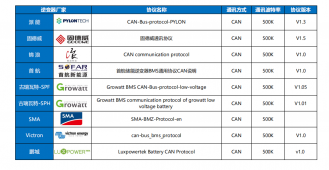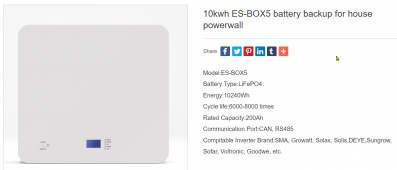Yes, more or less: I guess you want another battery that behaves like a Pylontech US 2000 that you can build on your own, right ?
If so, here is your
general masterplan, what you will need to get it well done and then I will explain the details
#1 buy a SEPLOS BMS with the max current (A) the pylon tech are rated ( I do not have Pylontech, but I know my buddy)
#2 buy a Neey actice balancer (without you will not keep the cells together) if you get cells bigger than 50A
#3 build the battery as provided by the link below
#4 take your Laptop or any windows 10 PC and connect it with the USB cable to RS485 they offer
#5 install the software they offer and then you have to choose the can bus protocol for Pylon Tech US 2000
#6 you can configure all the details like cut off voltage, over protection and many, many more this way
Purchases:
#1 get it from Alibaba where SEPLOS has a shop. This way their BMS is cheaper and better protected (by Aliexpress and PayPal) compared to an order from their own website where you have to ask for a quote and much more.
#2 EU customers and US customers (not so sure, but I guess) will get a quote based on ddp or ask for it cause that includes customs, tarifs and VAT / sales tax and shipping. the BMS is affordable, but 200€ or 200$ and 30$ for shipping sound way to much except you be aware that 30$ includes all the customs, tarifs, taxes and fees.
#3 if you order from Alibaba get the right version cause there are 20 or so different offers all looking pretty much the same, but are not the same. I strongly recommand to get the right current, then check for the size like 12 to 20S or so and get the bundle, which includes the display that shows all the data you want to see and you might wanna change later without the Laptop connection and THE CABLE ADAPTER the provide for 20$.
If you are familiar with IT and electronics then you have the change to save 17 $ or so and try to find a usb ftdi adapter to RS485/Can Bus which are usually 3 or 4$ / €.
If you prefer the safe side get the 20$ adapter cause you might need it more than once for example for firmware updates.
Be aware: this cable is your only data connection to the battery and its BMS
Build and a kind of review:
Andy, a german imigrant in Australia, has done a full documentation of a SEPLOS battery build using the case and the cells SEPLOS does offer as a full kit (rack battery 6,9 kWh) - but do not buy that cause the cells he had gotten were from 2019 so 3 years old.
BUT: to build this battery with all the parts SEPLOS has provided shows you all the details how to build your own battery and he has also done another video to explain the BMS and all its parameters in the PC Software and via Display Menu which is mandatory for the Kit buyers.
Attention: Andy has purchased 2 'batteriy solutions' that SEPLOS offers: the full kit incl. cells for a 6,9 kWh battery and another kit for one particular cell, the EVE LF280K with 280 Ah, he had to provide / buy on his own.
This will be his second build of a SEPLOS BMS but I guess this will provide maybe some more views.
Andy is a german professional and goes into all the details and checks everything.
He blames bad products and suppliers on his channel , but also offers help to the manufacturers that overpromise and did not deliver.
So you find on his channel a lot of active balancer videos and test, a lot of crap and bad like the one from Neey, but Neey asked him for help to improve the product and now he is quite happy.
This solution works if you connect the diy battery to a growatt inverter, but I bet it will need a free port to do so. I am not aware if and how you could stack the 2 pylons (which I assume do act as 1 battery with 1 canbus or RS485 cable) with the DIY battery. So check out if you have 2 canbus or RS 485 ports
Finally here is
your choice of CAN BUS Protocols: Pylon Tech V1.3 should do the trick.
View attachment 108599
I think you will need 2 can-bus ports on your inverter to get it done or your pylontech are building a chain with 2 port on each battery for canbus out and in and then you might be able to put all 3 in 1 chain but I have my doubts that this might work cause I bet the inverter wants to talk to each BMS directly and not over another BMS. So I am not the expert as you can see, but you might open a new topic about Pylon Tech and DIY built 'bundle' and how the can-bus should be working.
Here the links
FTDI adapter on german amazon but you will understand what you will need. Most likely cheaper on Ali Express
https://www.amazon.de/dp/B094VTGGV1
SEPLOS BMS = ALIBABA SHOP
attention: this is the german description but you will find the description and you can switch the language in the upper right to english .
Seplos 50a/100a/150a/200a 24v/48v Can/rs485 Batteries Chutz Platine Balance Lithium Smart 48v Lifepo4 Bms - Buy Bms,Seplos 50a/100a/150a/200a 48v Smart Bms,Lifepo4 Lithium Battery Protection Board Currant Balance Bms Lifepo4 Product on Alibaba.com
german.alibaba.com
SEPLOS BMS youtube presentation / configuration by SEPLOS
SEPLOS BMS by Andy - but this is in depth and takes about 1 hours with all its test if the BMS is working properly cut of voltage or low temperature warning and more.
I have searched for 6 months for a BMS that could handle the growatt canbus implementation and this was the only one. JK BMS claimed to have that too, a can bus port for growatt and I had bought the BMS from them. But at arrival it became obvious that they had fooled me and I had to search again till I found the SEPLOS. There is no other BMS that achieve this variety of inverter brands (and more than those mentioned in the table above). There is only 1 other BMS which is not available for us end consumers which is used by rack battery manufacturers to offer also a wide variety of inverter brand protocols and different model specific protocol versions like Growatt with one for the SPH and another one for ESF series.
Good luck !






